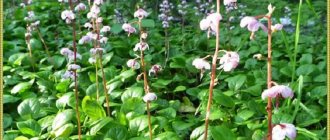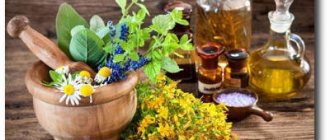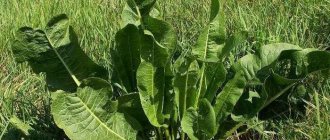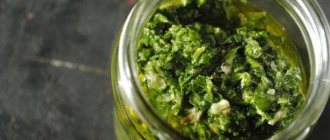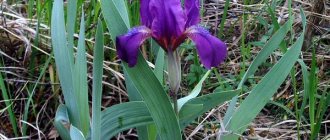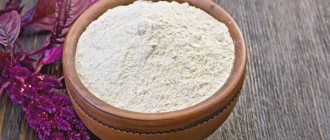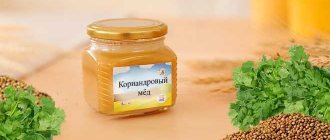Clover honey - what is it?
Clover is characterized by good honey-bearing properties; trefoil flowers contain a large amount of nectar, which bees collect with great pleasure. However, clover grows in cool countries, where it blooms at temperatures of 7-10 degrees, so it is rarely found in our country.
There are clovers with red, white and white-pink flowers. It is very difficult for bees to obtain nectar from red varieties, so this is the rarest species, collected only in the Caucasus. But white and white-pink flowers are the most common varieties for beekeeping.
The beneficial properties of clover are also transferred to the honey product, which is why it is often used in folk medicine. It is used to treat diseases of the gastrointestinal tract, nervous system, colds and restore the nervous system. Widely used for cosmetology, production of creams, scrubs and masks.
Storage rules
This variety is prone to rapid saturation with moisture; it quickly absorbs all odors, which is not advisable to allow. Optimal storage conditions for clover honey:
- The room where the containers are located must be dry and free of unpleasant odors;
- Glass jars will be an excellent container for storing it;
- The desired air temperature in the room with jars should be about 10 degrees Celsius, minor deviations are acceptable;
It is not recommended to store honey for more than one year, as it will lose all its beneficial components and change in taste. At high humidity, the nectar will begin to ferment.
How to distinguish fake from natural honey? A transparent and liquid consistency indicates its pasteurization; such a product is not worth purchasing. Natural honey should be packaged in a glass container.
Honey card
| Color | light, transparent, white after crystallization. |
| Taste | pleasant, sweet, long fruity aftertaste. |
| Aroma | delicate, floral. |
| Crystallization time | long-term, from one to several months. |
| Viscosity | thick, viscous, viscous. After crystallization it acquires a dense fine-grained structure. |
| Calorie content | 309 kcal per 100 g. |
| Geography of collection | everywhere. The distribution area is extensive: Europe, Asia, Africa, found on the west coast of South America and North America. |
| Collection period | blooms in early summer, active nectar production lasts more than a month, can bloom again after mowing. The best time for taking a bribe is considered to be moderately humid weather with an average plus temperature of 200C. |
Types of honey clover
White creeping, red meadow and pink varieties are widespread. Sweet clover with small yellow flowers is also prized. In different regions it is called honey clover, burkun, sticky or wild buckwheat.
- The productivity of the white variety is up to 100-150 kg of honey per hectare.
- The yield of red clover is lower - 25-30 kg: collecting nectar from it is more difficult due to the structural features of the corolla.
This species is preferred by bumblebees, long-proboscis Caucasian bees and hybrid breeds crossed with them. The flower adds aroma and tenderness to the taste of polyfloral honeys.
Recipes for clover honey
20.05.2018
Clover is a perennial from the legume family that has medicinal properties. Attracts bees and bumblebees with an abundance of sweet nectar. Clover honey and its healing properties have been used by people for over three thousand years. In the treatises of Hippocrates there are recipes for the treatment of wounds, the main component of which is this beekeeping product.
Features and Specifications
The time to collect clover honey is at the beginning - mid-summer. Plants bloom in June, intense nectar production lasts 4–5 weeks.
Under favorable weather conditions, they produce a second harvest after mowing. Fragrant honey is obtained when collected in June, at moderate humidity and a temperature of +25–28 degrees.
Since trefoil does not occur in isolation from other flora, the honey composition is diluted with meadow herbs.
The finished product has a light, pleasant floral aroma. The fresh mass is transparent, with a slight amber tint, fluid, viscous, but not liquid. Keeps this consistency for 4-8 weeks.
When nectar is collected from red clover2284, the honey has a delicate pinkish-yellow color. Crystallizing, the product becomes creamy white and acquires a fine-grained, dense structure.
The taste is caramel, moderately sweet, with a pleasant fruity aftertaste, without astringency or bitterness.
If in the autumn-winter period you find clear honey in liquid form on sale, refuse to purchase: there is a high probability that it is a fake or pasteurized product. It has no healing effect and will not bring any benefit.
Compound
Clover honey contains biologically active substances that have a multifaceted effect on the body:
- fructose, glucose, sucrose, maltose;
- essential oils, tanning components;
- flavonoid compounds, proteins, enzymes;
- acids of organic origin (acetic, formic and salicylic);
- minerals (potassium, zinc, magnesium, sodium, phosphorus, selenium, cobalt, manganese, calcium);
- antioxidants, phytoestrogens and dextrins;
- water-soluble vitamins of groups A, B, C, K, E, PP.
Slight differences in the composition of honey are due to the places of collection, climatic and weather conditions, and accompanying herbs.
Types of honey clover
White creeping, red meadow and pink varieties are widespread. Sweet clover with small yellow flowers is also prized. In different regions it is called honey clover, burkun, sticky or wild buckwheat. The productivity of the white variety is up to 100-150 kg of honey per hectare.
The yield of red clover is lower - 25-30 kg: collecting nectar from it is more difficult due to the structural features of the corolla. This species is preferred by bumblebees, long-proboscis Caucasian bees and hybrid breeds crossed with them.
The flower adds aroma and tenderness to the taste of polyfloral honeys.
Application area
To increase the healing effect, the apiproduct is useful to use together with tea, infusion or decoction of clover. To maintain medicinal properties, add honey to drinks whose temperature does not exceed +50 degrees. The beekeeping product is used in the treatment of the following diseases:
- ARVI, acute respiratory infections, flu, colds, bronchitis, tonsillitis, pneumonia;
- boils, wounds, cuts and burns;
- eczema, dermatitis, psoriasis, vitiligo, acne;
- formation of stones in the bladder;
- inflammatory processes in the ovaries and appendages in women;
- bleeding due to gynecological problems;
- stomach and duodenal ulcers, gastritis;
- liver failure;
- diseases of the cardiovascular system, hypertension, high cholesterol;
- sleep disorders, neuroses, stress, nervous exhaustion.
In the postoperative period or during recovery after a long illness, honey strengthens the immune system, speeds up recovery, and increases appetite.
Traditional medicine recipes
To prevent flu and colds, it is useful to take a vitamin drink daily. To prepare it, dilute a teaspoon of honey and freshly squeezed lemon juice in 200 ml of warm water.
Cough
To improve the separation of mucous secretions, homemade syrup is effective. Boil the lemon over low heat, after 10 minutes remove from the heat, squeeze the juice into a glass, add 30 ml of glycerin. After stirring, add honey. For intense cough, shake first and drink a teaspoon 6 times a day.
According to another recipe, rinse the radish, cut a hole in the top, and put 40–50 g of honey in it. Leave for 4–5 hours. Drink 15 ml 3-4 times a day. In the absence of allergies, children can be given carrot juice with clover honey in a ratio of 1 to 1. For external use, use warming compresses, apply them to the lung area on the chest and back.
Osteochondrosis and joint pain
Mix 25 ml of aloe juice, 75 ml of vodka, 50 g of honey. Apply the solution to a thick cotton cloth, secure, and apply before bed. In the morning, wash your skin.
Ulcer and gastritis
For 6 tablespoons of crushed aloe leaves, take 15 clover honey. Place in a dark place for 72 hours. Strain and add 5 tablespoons of wine. Drink before meals 3 times a day. The course of treatment is 8 weeks.
Insomnia
Mix half a glass of lemon juice, walnut kernels and a teaspoon of honey. Take 30 ml before bed. A drink of 200 ml of warmed milk with 10 g of honey helps you relax and fall asleep.
Storage conditions
Honey absorbs moisture and foreign odors, so keep it in a tightly closed glass container at a temperature of +10–12. Do not use metal containers.
Avoid direct sunlight on the jar. Consume honey within 12 months, before the next harvest, otherwise the beneficial qualities will be lost.
Do not heat-treat, as heating reduces the healing effect of the apiproduct.
To avoid sugaring and hardening during crystallization, cream honey production technology is used.
The resulting mass retains all valuable qualities and is easy to use due to its structure and delicate consistency.
The honey is thoroughly beaten, the crystals are destroyed, the viscosity decreases, and a homogeneous airy mass is obtained, which is easy to spread on bread or add to baked goods. The shelf life of cream honey is up to 1 year.
Recipes for clover honey Link to main publication
Source: https://floradoc.com/stati/retsepty-na-medu-iz-klevera
Composition and calorie content
Clover is a plant that produces honey with different components. This is influenced by the following factors: locality of growth, climate, proportion of pollen from other honey plants, favorable weather conditions, collection period. Common components included:
- carbohydrates – 78–82% (fruit sugar 39–41%, glucose 34–36%, sugars, maltose, polysaccharides);
- protein substances, amino acid complex, dextrins, enzymes;
- vitamins – ascorbic acid, niacin, groups B and K, tocopherols;
- trace elements, minerals – iodine, boron, selenium, sodium, magnesium, zinc;
- organic acids – lactic, citric, acetic, oxalic;
- antioxidants, tannins, oily esters;
- phytoestrogens, salicylic acid;
- moisture – 16–18%.
The calorie content of clover nectar is 307–310 kcal per 100 g, which is considered low for beekeeping product varieties.
For convenience, take the following calculation:
- small spoon – 35–38 kcal,
- large spoon – 106–109 kcal.
- A glass contains 1110–1113 kcal
Chemical composition
The geography of collection, weather, climate, and accompanying grass determine the differences in the composition of this high-grade product, but in general it looks like this:
| Compound | Content, %% |
| Water | before 18 |
| Carbohydrates (fructose and glucose, sucrose is slightly present, and to an even lesser extent maltose, melitose and other disaccharides) | up to 82 |
| Minerals | less than 1 |
| Water-soluble vitamins, proteins, enzymes, amino acids and dextrins | until 3 |
Natural honey contains from three hundred to four hundred types of active compounds and substances. Their list changes and depends on various factors, but the following elements remain constant:
- macro and microelements (potassium, iodine, copper, manganese, sodium, magnesium, calcium, selenium, phosphorus, cobalt, aluminum and others)
- enzymes, proteins, dextrins, amino acids and antioxidants
- vitamins (ascorbic acid, folic acid, B vitamins, as well as E, K and PP).
Clover honey contains
- salicylic acid
- essential oils
- flavonoids
- carotene
- tannins
- phytoestrogens.
It is the presence of phytoestrogens that determines the direction in which it is used by homeopaths, apitherapists and traditional medicine.
Compound
Clover honey contains:
- enzymes;
- micro- and macroelements;
- sugars (simple, complex);
- water.
This is interesting Fireweed honey
The percentage of glucose is about 35%, fructose is 40. The diastase number is in the range of 5.3-12. Clover flowers produce a lot of pollen. The exact composition of honey depends on the geography of collection.
The variety also contains flavonoids, esters, salicylic acid, tannins, carotene, and phytoestrogens. It is due to phytoestrogens that nectar is loved by traditional healers, apitherapists and homeopaths.
Useful and healing properties
- The beneficial properties of clover honey earn it a place alongside the best high-grade honeys. It has all their good qualities, but also has a number of differences.
- Clover honey is one of the sweetest. It owes its sweetness to its high fructose content and is considered third after honey products made from raspberries and coriander. This quality is important for people who try to limit caloric intake. To create a sweet taste, they require less of it, and accordingly they can reduce the number of calories consumed.
- Clover honey has an excellent expectorant effect. During the cold season, it is very useful to take it for bronchitis and respiratory diseases.
- Pediatric doctors enjoy using this sweet product in their practice. Children are usually capricious about the taste and aroma of sweet treats. But clover honey, with its neutral taste and aroma, is always consumed with pleasure.
- Regular intake of honey calms the nervous system, helps normalize sleep and blood pressure. It is especially useful in the postoperative period, as well as during long-term debilitating diseases and during the recovery period.
- Clover honey improves the functions of the gastrointestinal tract. Taken before meals, it promotes the secretion of gastric juice. And if you consume it 1.5 - 2 hours before meals, the secretion of gastric juice will be reduced.
- Clover honey is widely used in cosmetology as part of creams, ointments, and gels. It promotes skin cell regeneration and has good bactericidal properties.
Clover honey - beneficial properties
The chemical composition and purity of nectar are factors that influenced the breadth of use of the bee product for medicinal purposes. Clover honey exhibits the following beneficial properties:
- astringent and hemostatic effect;
- elimination of symptoms of the inflammatory reaction;
- liquefying and activating the release of sputum - helps fight dry cough, sore throat, sore throat;
- destructive effect on pathogenic bacteria, viruses, fungi;
- strengthening the body's protective barrier;
- recovery after operations, serious illnesses;
- calming the nervous system - combating stress, depression, neurosis, psycho-emotional disorders, insomnia;
- activation of metabolic processes;
- normalization of the functioning of the digestive tract;
- stabilization of water-salt and acid-base balance;
- cleansing the body of waste, toxins, “bad” cholesterol;
- improving blood clotting, normalizing blood pressure;
- strengthening the regenerative abilities of cells and tissues.
Beneficial properties are used to treat respiratory, viral, colds: sore throat, bronchitis, influenza, pneumonia. The components of the bee product successfully cope with gastritis, ulcers, and gallstones. Clover honey helps with liver failure, cirrhosis, and hepatitis.
The bee product is used to treat skin lesions: eczema, wounds, burns, boils, psoriasis, acne. Clover nectar is useful for combating gynecological diseases. Honey is recommended for women for cosmetic purposes: to eliminate wrinkles and improve skin health.
Contraindications
Despite all the beneficial characteristics of clover honey, we must not forget about some contraindications in its use. Pollen, which is present in honey, contains many aggressive components. In some cases, they can cause individual intolerance. It would be useful to do a test before using honey to know for sure whether there are any contraindications.
When regularly consuming honey, do not forget about its effect on teeth and the danger of caries. It would be appropriate to at least rinse your mouth after each appointment, or better yet, brush your teeth.
People suffering from diabetes should pay attention that honey contains a lot of fructose. Therefore, you should consult your doctor before using the product.
Clover honey has great nutritional value. People who are on a diet and struggling with excess weight, when creating a menu for the day, need to take into account the calorie content of honey and include it in the diet in small doses.
Also, some substances that are part of honey have a negative effect on diseases such as varicose veins, estrogen-dependent pathologies in gynecology, thrombophlebitis and increased blood clotting. Honey is contraindicated for pregnant and breastfeeding women.
What diseases does it help with?
Natural antibiotic. Despite the wide possibilities of traditional medicine, the good old way of fighting burns and against suppuration of wounds with the help of clover honey has not sunk into oblivion. The regenerative capabilities of the product are due to the fact that it contains a lot of ascorbic acid (vitamin C) and microelements such as iron, potassium and honey. Clover honey is merciless against infection-causing bacteria, including types that are resistant to antibiotics. In addition, the anti-inflammatory properties of clover honey are due to the acidic pH factor, the ability to quickly crystallize (the lack of excess liquid creates a kind of “drought” in the bacterial habitat) and the presence of hydrogen peroxide, which is formed in concentrations that are not dangerous to humans due to some enzymes present in the product.
Protecting vascular health. A 61-year-old woman suffered from incessant headaches and dizziness for several years. Then the pressure began to jump. Doctors diagnosed cerebral atherosclerosis with a tendency to vasospasms. Treatment in a hospital gave only a short-term effect. Following the advice of a friend, the patient began to regularly consume clover honey, washing it down with warm tea. A month later, a small miracle happened: the hypertensive crises practically subsided, the woman stopped being tormented by rapid heartbeat, she became calmer, and began to fall asleep easier. And if earlier she went to the department almost every month and a half, now she is limited to planned courses of treatment once every six months. Of course, she continues to take some hypertensive medications, but she never gives up her favorite clover honey. And rightly so, since in it researchers have identified a large number of antioxidants that inhibit the oxidation of those lipoproteins that make up the so-called bad cholesterol. It is also useful to use this type of honey for people who, thank God, do not suffer from hypertension, which will be an excellent prevention of vascular atherosclerosis.
So that the cough does not bother you. Young children cough often. Moreover, they don’t have to have a cold to do this. Not only mothers, but also many pediatricians shrug their shoulders, not knowing how to help such babies. They write it off as some kind of allergy, something “age-related” (like “it will go away on its own”). Meanwhile, the best medicine in such cases is clover honey. Especially if the child is not yet four years old and synthetic cough medications are contraindicated for him. This product is completely natural and safe, which makes it an effective alternative to medications. Both when treating adults and, of course, when treating young children. Clover honey, exhibiting its antioxidant properties, acts very gently (especially in terms of removing mucus from the bronchi), but effectively. Traditional medicine offers a very simple recipe specifically for children so that they do not cough: dissolve a teaspoon of lemon juice in a glass of warm water and wash down with a teaspoon of honey.
For liver and gastrointestinal health. Nowadays people often complain about problems in the gastrointestinal tract and liver problems. This is not surprising considering that many people abuse dangerous food, that is, various fast foods, products with preservatives and containing genetically modified organisms. Daily consumption of clover honey at least 1-2 dessert spoons (subject to a reduction in the diet or a complete rejection of harmful products) will perfectly stimulate the gastrointestinal tract, have a beneficial effect on the functioning of the liver, gall bladder and biliary tract, and will become a natural factor in suppressing tumor processes in them. The sugars contained in clover honey, as we have already said, are easily absorbed by the body. Therefore, this type of honey will not have any additional stress on the stomach, intestines, or liver.
Diuretic properties. This beekeeping product has proven itself to be a good diuretic. If a person develops swelling or has difficulty passing urine, then, of course, he must undergo all medical examinations and, having established the causes, take adequate treatment if necessary. Not forgetting about such a natural diuretic as clover honey. And in combination with warm green tea, it can work wonders, helping to eliminate toxins and metabolic products from the body through urine.
Natural blood purifier. With age, the blood thickens and becomes clogged due to an unhealthy diet and taking a large number of medications. Its ability to transport oxygen to tissues is reduced. As a result, various types of hypoxia occur, leading to serious consequences. But you can put a reliable barrier against these phenomena if you regularly eat clover honey, which is also known as a good natural blood purifier. This is especially welcome after surgery or a long-term illness, when the body especially needs restoration. And when the blood is “dirty”, then there is no need to talk about quick rehabilitation.
For women's health. In traditional medicine, clover honey is used in the treatment of gynecological diseases. And far from unsuccessful. This product also receives good reviews as a treatment for hemorrhoids. And continuing about women: clover honey is used as a raw material for the manufacture of some cosmetics that restore youth and beauty to the fair sex.
How not to buy a fake
- Natural honey should not contain any fragrances or vitamins.
- Place several dots on the surface of the product with a chemical pencil - if they turn blue and blur, then this is not clover honey, but ordinary sugar molasses with a thickener.
Remember that real nectar has a light, distinct floral aroma. It is completely transparent only in the first two months (and then maximum) after pumping, after which it becomes white, dense, dense, and acquires a fine-crystalline structure.
Is molasses harmful? In large quantities, yes, in small quantities it is simply useless.
When using this variety in the treatment of various diseases, keep in mind that honey does not replace the classical treatment program, but only complements it. By refusing a treatment regimen prescribed by a doctor, you act at your own peril and risk, under your own responsibility.
Description and characteristics of clover honey
At first glance, it may seem that clover is not of particular value, because all its use usually comes down to livestock feed, but in beekeeping this plant is considered one of the main and most reliable honey plants. Today, some countries, including Canada, the USA and New Zealand, are narrowly engaged in the cultivation of clover in order to import clover honey abroad.
Features of storing honey in honeycombs
Among all the varieties of clover, bees especially “loved” white, red and Swedish, and the last two are specially cultivated and bloom for no more than a month. The beekeeping product itself - clover honey - is one of the high-quality varieties and is famous for its excellent taste, aroma and medicinal properties.
What does it look like
A distinctive feature of fresh clover honey is its thickness. Crystallization of the product, however, occurs quite easily, so it soon becomes dense and acquires a granular structure. The resulting finished product should be very viscous and viscous in consistency, and should have a pronounced floral aroma.
Did you know? In Ancient Egypt, honey was so valuable that it was considered a full-fledged analogue of money. It was believed that a hundred pots of nectar were comparable in value to cattle. Subsequently, this system was adopted by the Romans.
—
taxes in the ancient Roman Empire could be paid either in gold or honey, and even among the ancient Slavs, a fine could be paid either in money, or in cattle, or in honey.
Color
Natural clover honey becomes white or pale amber in color after candiing. When fresh, such a product will be distinguished by its colorlessness and even transparency. The exception is nectar obtained from red clover flowers, in which case it will have a slight reddish tint. The color does not affect the taste and beneficial properties of the product.
Taste and aroma
In terms of taste, clover honey is in no way inferior to other varieties and is even considered one of the most delicious and sweet, which will especially please those with a sweet tooth. The taste of natural nectar is light and very delicate, slightly reminiscent of caramel candy. The fresh product leaves behind a long aftertaste, which is characterized by unobtrusive fruity notes, is easily digestible and does not taste bitter. Has a rich floral aroma.
Sugaring time
Nectar is collected in the spring, which subsequently ensures easy but long-term crystallization - from 1 to 3-4 months. It is believed that honey collected in the spring is much better and tastier; This can be determined by the smell - the later it was collected, the more intense the smell will be. The longest period of sugaring belongs to red clover honey - from 4 to 5 months, and during the process this product will lose its red tint, gradually turning into a white homogeneous mass.
